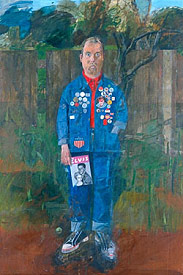
| HOME |
| NERVE |
| REVIEWS |
| ARCHIVE |
| EVENTS |
| LINKS |
| ABOUT US |
| CONTRIBUTORS |
| BACK ISSUES |
| CONTACT US |
 Peter
Blake: A Retrospective
Peter
Blake: A Retrospective
Tate Liverpool (29th
June - 23rd September 2007)
£5 (£4 concessions)
Reviewed by Adam Ford
It was Oscar Wilde who said 'A work of art is the unique result of a unique temperament. Its beauty comes from the fact that the author is what he is.' If we judge Peter Blake by that standard, it's doubtful he is an artist at all, rather than just a highly skilled copyist. Throughout his career he has worn many different badges, but never made one of his own.
Blake got to art school on the strength of a portrait of his sister. There he learned still lifes and 'what was called composition', which he describes as being a 'prescribed Victorian way of working'. It was probably during this period that Blake put the most of himself into his work, literally in many cases (see left).
For about fifteen years in the 1950s and 60s, Blake rode the crest of the pop art wave, as a kind of British Andy Warhol. His work is drenched in the mass marketed youth culture of the time. However, unlike with Warhol, there is no sense of social commentary in Blake's pop art. Instead, pin-ups are presented 'as is', giving the impression that the painter didn’t apply any kind of filter. Popular culture in, popular culture out.
The defining moment in Blake's career came in 1967, when he landed the job of designing a cover for Sgt. Pepper's Lonely Hearts Club Band. Of course, the collage quickly became one of the most iconic images in rock history. From that moment, he was the man who did that cover.
At the end of that decade, with Vietnam protests, civil rights movements and student rebellions convulsing the western world, Blake retreated into himself. Suddenly modern wasn't interesting anymore, and he set off in search of the countryside and the simple life. He founded a group called the Brotherhood of Ruralists, and tried to make 'a certain kind of English painting', with references to a bygone upper class culture. His technique was self-consciously 'traditional', and there was more than a tip of the hat to the pre-Raphaelites.
As Thatcher and Reagan began their reigns of terror in the UK and US, Blake moved on to painting scenes of beach parties in Los Angeles thrown by his rich friends. No doubt many of them are now gazed at nostalgically by those who were there. In 1994, he became Artist in Residence at the National Gallery in London. Here again, he deliberately imitated the style of others, this time Pietro Longhi and Francisco Zurbarán, which he mixed with knowing references to yet more famous painters. This culminated in 'The Marcel Duchamp World Tour', where the long dead Dadaist got to meet the Spice Girls and Elvis. That's Marcel Duchamp the true innovator, reduced to jaded replica.
In his interview with Nerve last year, Blake expressed no sympathy for the many local artists struggling to make ends meet, despite the Capital of Culture money rolling into the city:
'I don’t think artists should be sponsored. You should not rely on grants. You either make a success of your art or you don’t.'
That's an easy thing for him to say. After all, he made his name by designing that sleeve art, itself nothing more than a large-scale cut and paste affair. The success of the songs on the album therefore contributed more to his bank balance than his own skill as a creator.
Perhaps even significantly, an artist who wants to make a living from selling their work must accommodate themselves to the tastes of those rich enough to buy it. For better or worse, this is something that Peter Blake has continuously done over the last half century.
Blake's next major commission is for the Capital of Culture.
Comments:
Comment left by Kenn Taylor on 17th July, 2007 at 16:17
An excellent critique, I've always been largely underwhelmed by Peter Blake's work too. Though I do agree with him that I'm suspicious of sponsoring individual artists. If you are a true artist, you would still create even if it was not in your economic interest, perhaps even if it put your life in danger.
Comment left by Adam Ford on 17th July, 2007 at 16:37
of course you're right, and that's what many great artists have done. The last thing I want to see is loads of mediocre artists paid for by the government. But an artist's work will always be shaped by the world they find themselves in, and in Blake's case, it is a self-satisfied one I don't think many people could relate to.
Comment left by Terri on 26th March, 2008 at 16:45
would Blake be saying that if he didnt make it as a famous artist? No, he would have been strugling and needed a grant 'to make ends meet' like the rest of us who don't have rich mummys and daddys or whatever I don't know the history but you get my drift.I'm just saying, give people a chance, it's hard being an artist people like your work or tey don't. But if you are going to get a grant, don't take the piss and be a Tracey Emin!